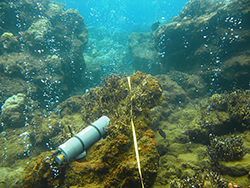AIMS leads studies of coral reefs and seagrass meadows near shallow volcanic CO2 seeps or vents in Papua New Guinea. Bubbles of carbon dioxide rise up from cracks in the reef surface, naturally altering the chemistry of the surrounding seawater, turning it more acidic.
Ecosystems at seep sites have had hundreds of years of exposure to elevated levels of CO2. First discovered by our researchers in 2010, the seeps are a ‘natural laboratory’ to study how tropical marine ecosystems may adapt and how organisms acclimatise after generations of exposure to high CO2. Short-term laboratory experiments cannot provide such information on changes at the level of whole ecosystems.
Coral and seagrass ecosystems surrounding these seeps contain the same species found on Australia’s Great Barrier Reef and Indo-Pacific coral reefs, making research from these seep sites directly applicable to these regions.
This collaborative study involves over 40 researchers from 20 institutions across nine countries. The work produced by this team is revealing the fate awaiting tropical marine ecosystems in coming decades if atmospheric levels of CO2 continue to increase.
Seeps as a time machine into an increasingly acidic future
Swimming along CO2 gradients is like travelling into a high CO2 future in a time machine. Away from the seep, the concentration of CO2 is normal, as it the acidity. As you swim toward the seep, CO2 increases and acidity of the seawater is highest next to the vents. Scientists use these gradients to measure the responses of reef dwellers to ocean acidification, and predict how communities will change over time as CO2 continues to increase.
Ocean acidity is measured as ‘pH’, a measure of the concentration of hydrogen ions, on a log-10 scale: e.g., pH 7 is ten times less alkaline (more acidic) than pH 8. Today, tropical seawater has a pH of about 8.0. Benthic foraminifera, which are important producers of sand, are absent below pH 7.9 , a level that may be reached towards the middle of this century. Crustose coralline algae, which are important for coral recovery, are rare below pH 7.8 . Importantly, the density of coral recruits also declines with pH, and is low below a pH of 7.8, possibly because the crustose coralline algae are missing.
Predicting future changes and thresholds for reefs under increasing ocean acidification provides the scientific basis for informed management decisions to help protect the health of coral reefs.
Reef communities near seeps
Our studies at the seeps have found clear winners and losers in coral reef communities under high CO2
- Fewer branching corals, and less diversity
Large boulder-like corals can live under ocean acidification, while the more CO2 sensitive branching (bushy) corals are rare. Branching corals are home to many reef critters, such as small fishes, crabs, shrimps and sea stars. As a result, ocean acidification has a domino effect: as the coral habitat structure decreases, the animals that live and hide in their nooks and crannies find it far harder to survive, simply because they lose their habitat.
- More seagrass and seaweed
In contrast, seagrasses and seaweed benefit from the higher CO2, as it supports their photosynthesis. Both groups are very abundant at the seeps, providing food for algal grazing organisms but also competing for space with corals.





